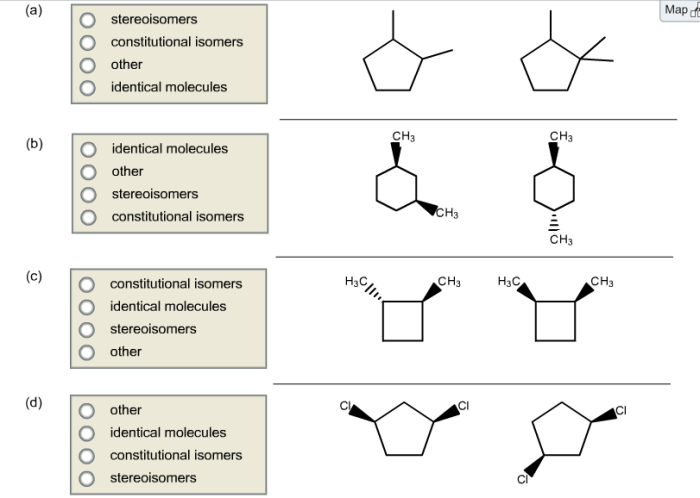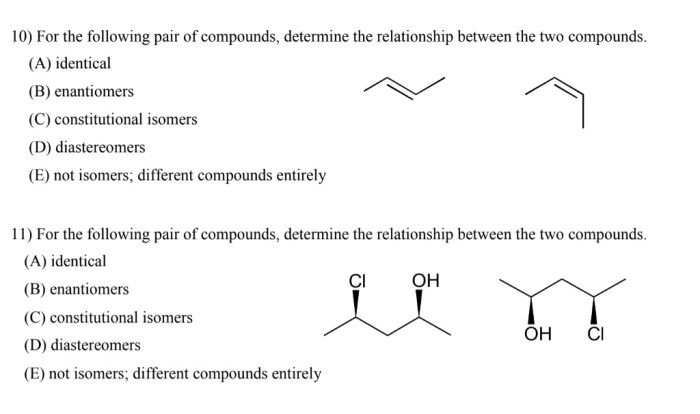Which pair of the following compounds are constitutional isomers? This question delves into the fascinating world of constitutional isomerism, where compounds with identical molecular formulas exhibit distinct molecular structures and properties. Constitutional isomers arise from variations in the arrangement of atoms within a molecule, leading to unique chemical and physical characteristics.
This article explores the concept of constitutional isomers, providing a comprehensive understanding of their identification, nomenclature, properties, and practical applications.
The second paragraph delves into the intricacies of constitutional isomerism, discussing the underlying principles and providing illustrative examples to enhance comprehension.
Constitutional Isomerism: Which Pair Of The Following Compounds Are Constitutional Isomers

Constitutional isomers are compounds with the same molecular formula but different molecular structures. They differ in the arrangement of their atoms and the order in which they are connected. This difference in structure leads to differences in their physical and chemical properties.
For example, butane and isobutane are constitutional isomers. Butane has a straight chain of four carbon atoms, while isobutane has a branched chain of three carbon atoms and a methyl group.
Identifying Constitutional Isomers
To identify constitutional isomers, you need to determine the molecular formula of the compound and then draw all possible structural isomers. Structural isomers are compounds with the same molecular formula but different arrangements of atoms.
Once you have drawn all possible structural isomers, you can compare them to identify the constitutional isomers. Constitutional isomers will have the same molecular formula but different molecular structures.
Nomenclature of Constitutional Isomers, Which pair of the following compounds are constitutional isomers
Constitutional isomers are named using IUPAC nomenclature. The base name of the compound is determined by the number of carbon atoms in the longest carbon chain. The prefixes “iso-“, “neo-“, “sec-“, and “tert-” are used to indicate the position of alkyl groups on the carbon chain.
For example, butane is named as “butane” because it has four carbon atoms in the longest carbon chain. Isobutane is named as “2-methylpropane” because it has three carbon atoms in the longest carbon chain and a methyl group on the second carbon atom.
Properties of Constitutional Isomers
Constitutional isomers have different physical and chemical properties. These differences are due to the different arrangements of their atoms.
For example, butane has a lower boiling point than isobutane. This is because butane has a more compact structure than isobutane. The methyl group on isobutane makes the molecule more bulky, which increases its boiling point.
Applications of Constitutional Isomers
Constitutional isomers are used in a variety of applications. For example, butane is used as a fuel, while isobutane is used as a refrigerant.
Other applications of constitutional isomers include:
- As solvents
- As starting materials for chemical synthesis
- As drugs
Common Queries
What are constitutional isomers?
Constitutional isomers are compounds with the same molecular formula but different structural formulas, resulting in distinct arrangements of atoms within the molecule.
How can constitutional isomers be identified?
Constitutional isomers can be identified by analyzing their molecular structures and determining if they have different connectivity or arrangement of atoms.
What is the IUPAC nomenclature for constitutional isomers?
The IUPAC nomenclature system provides a standardized method for naming constitutional isomers based on their structural features and functional groups.

